MGT723 Research: Impact of Climate Change on Org Structure
VerifiedAdded on 2023/06/13
|9
|1732
|212
Report
AI Summary
This research report investigates the impact of climate change on organizational structure, focusing on the theoretical understanding of climate change and its effects on organizational frameworks. The study explores strategies to overcome these effects, examining factors such as management decisions, financial performance, and market valuation. A conceptual model illustrates the relationships between these constructs, supported by stakeholder theory. Hypotheses are formulated to test the relationships between management decisions, financial performance, market valuation, and organizational structure. The research employs positivism philosophy and a deductive approach, utilizing both primary (surveys) and secondary data collection methods. A mixed research design, incorporating qualitative and quantitative elements, is used, along with causal research to assess the relationship between climate change and organizational structure. Probability sampling is employed, and a time plan outlines the research schedule. The report also includes proxy measures for theoretical constructs such as agency theory, stakeholder theory, and legitimacy theory.

MGT723 Research Project
Assessment Task 1: Research Proposal
Student Name: XXX
Your assigned research topic*: Impact of climate changes on the organizational structure
Draft Research Question:
What is the theoretical understanding of the climate change?
What is the impact of climate changes on the organisational structure?
What are the strategies to overcome the effect of climate changes?
Title: Contemporary Issues in Accounting
Submission Date: XXX
Acknowledgment:
I certify that I have carefully reviewed the university’s academic misconduct policy. I
understand that the source of ideas must be referenced and that quotation marks and a
reference are required when directly quoting anyone else’s words.
* In ACC620 you were assigned to a theoretical perspective (Agency Theory, Stakeholder
Theory, or Legitimacy Theory)
Unless otherwise approved by the course coordinator, all students will be considering the
general issue of the Voluntary Disclosure of Environmental Performance.
Assessment Task 1: Research Proposal
Student Name: XXX
Your assigned research topic*: Impact of climate changes on the organizational structure
Draft Research Question:
What is the theoretical understanding of the climate change?
What is the impact of climate changes on the organisational structure?
What are the strategies to overcome the effect of climate changes?
Title: Contemporary Issues in Accounting
Submission Date: XXX
Acknowledgment:
I certify that I have carefully reviewed the university’s academic misconduct policy. I
understand that the source of ideas must be referenced and that quotation marks and a
reference are required when directly quoting anyone else’s words.
* In ACC620 you were assigned to a theoretical perspective (Agency Theory, Stakeholder
Theory, or Legitimacy Theory)
Unless otherwise approved by the course coordinator, all students will be considering the
general issue of the Voluntary Disclosure of Environmental Performance.
Paraphrase This Document
Need a fresh take? Get an instant paraphrase of this document with our AI Paraphraser
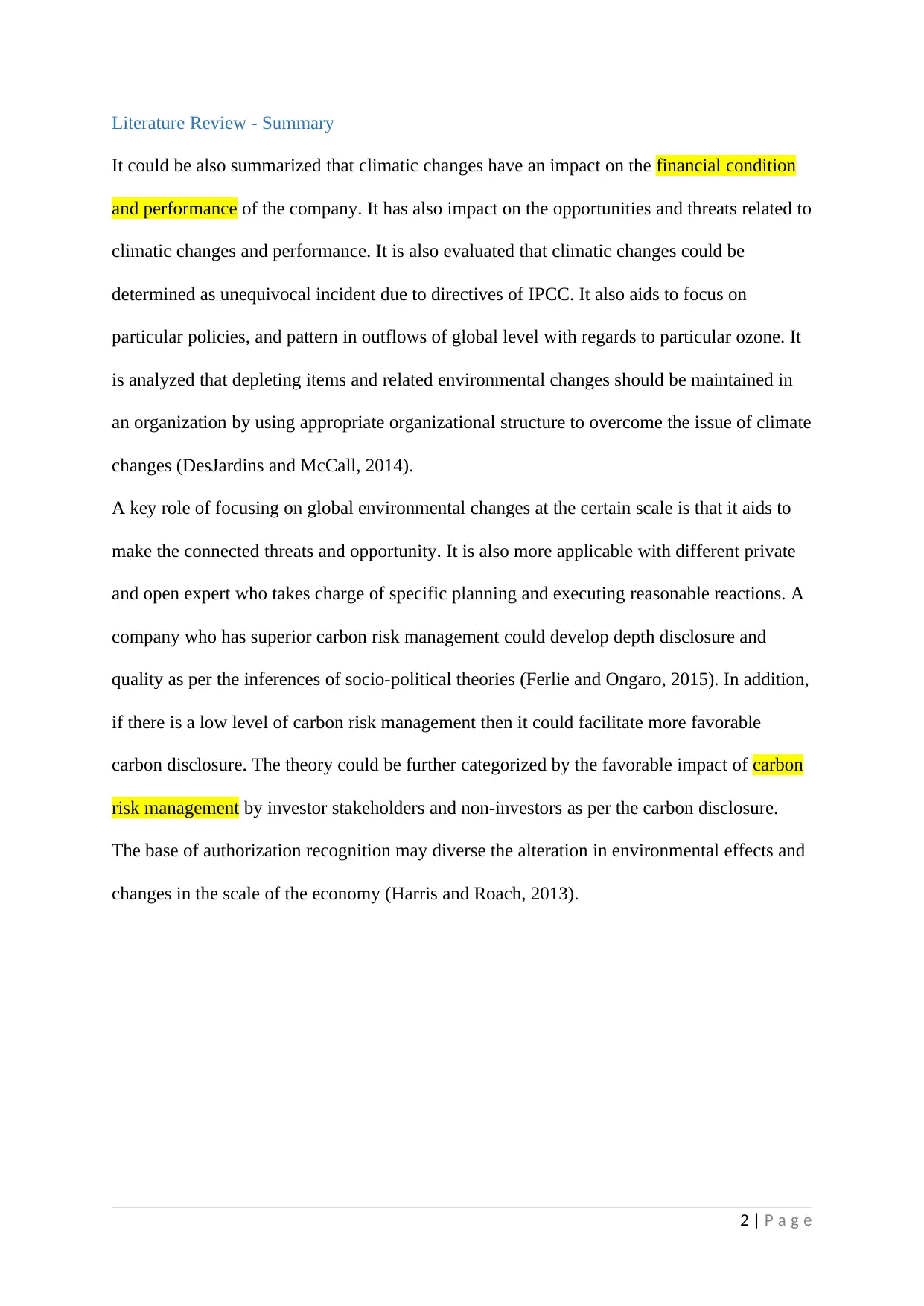
Literature Review - Summary
It could be also summarized that climatic changes have an impact on the financial condition
and performance of the company. It has also impact on the opportunities and threats related to
climatic changes and performance. It is also evaluated that climatic changes could be
determined as unequivocal incident due to directives of IPCC. It also aids to focus on
particular policies, and pattern in outflows of global level with regards to particular ozone. It
is analyzed that depleting items and related environmental changes should be maintained in
an organization by using appropriate organizational structure to overcome the issue of climate
changes (DesJardins and McCall, 2014).
A key role of focusing on global environmental changes at the certain scale is that it aids to
make the connected threats and opportunity. It is also more applicable with different private
and open expert who takes charge of specific planning and executing reasonable reactions. A
company who has superior carbon risk management could develop depth disclosure and
quality as per the inferences of socio-political theories (Ferlie and Ongaro, 2015). In addition,
if there is a low level of carbon risk management then it could facilitate more favorable
carbon disclosure. The theory could be further categorized by the favorable impact of carbon
risk management by investor stakeholders and non-investors as per the carbon disclosure.
The base of authorization recognition may diverse the alteration in environmental effects and
changes in the scale of the economy (Harris and Roach, 2013).
2 | P a g e
It could be also summarized that climatic changes have an impact on the financial condition
and performance of the company. It has also impact on the opportunities and threats related to
climatic changes and performance. It is also evaluated that climatic changes could be
determined as unequivocal incident due to directives of IPCC. It also aids to focus on
particular policies, and pattern in outflows of global level with regards to particular ozone. It
is analyzed that depleting items and related environmental changes should be maintained in
an organization by using appropriate organizational structure to overcome the issue of climate
changes (DesJardins and McCall, 2014).
A key role of focusing on global environmental changes at the certain scale is that it aids to
make the connected threats and opportunity. It is also more applicable with different private
and open expert who takes charge of specific planning and executing reasonable reactions. A
company who has superior carbon risk management could develop depth disclosure and
quality as per the inferences of socio-political theories (Ferlie and Ongaro, 2015). In addition,
if there is a low level of carbon risk management then it could facilitate more favorable
carbon disclosure. The theory could be further categorized by the favorable impact of carbon
risk management by investor stakeholders and non-investors as per the carbon disclosure.
The base of authorization recognition may diverse the alteration in environmental effects and
changes in the scale of the economy (Harris and Roach, 2013).
2 | P a g e
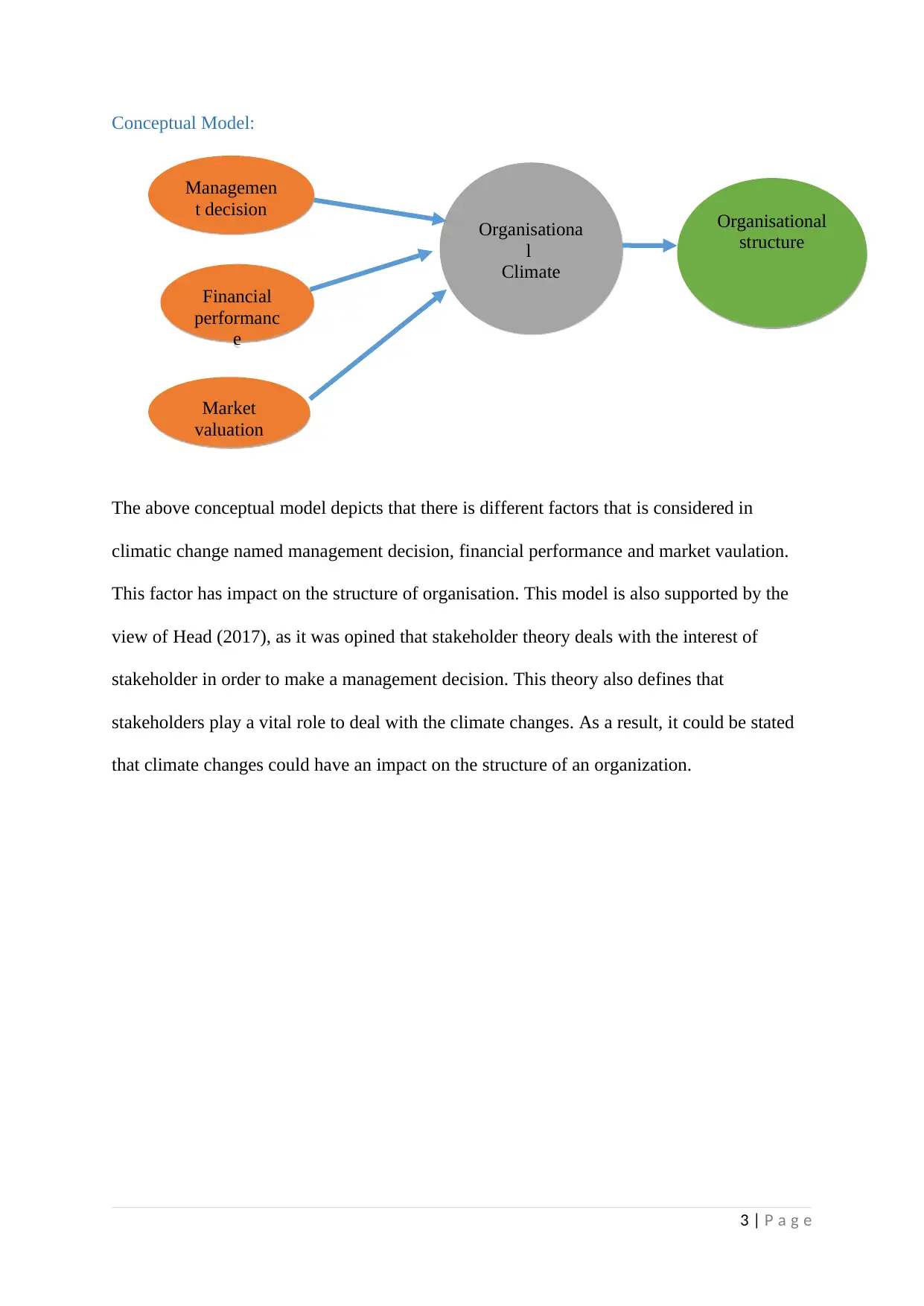
Conceptual Model:
The above conceptual model depicts that there is different factors that is considered in
climatic change named management decision, financial performance and market vaulation.
This factor has impact on the structure of organisation. This model is also supported by the
view of Head (2017), as it was opined that stakeholder theory deals with the interest of
stakeholder in order to make a management decision. This theory also defines that
stakeholders play a vital role to deal with the climate changes. As a result, it could be stated
that climate changes could have an impact on the structure of an organization.
3 | P a g e
Managemen
t decision
Organisationa
l
Climate
Financial
performanc
e
Market
valuation
Organisational
structure
The above conceptual model depicts that there is different factors that is considered in
climatic change named management decision, financial performance and market vaulation.
This factor has impact on the structure of organisation. This model is also supported by the
view of Head (2017), as it was opined that stakeholder theory deals with the interest of
stakeholder in order to make a management decision. This theory also defines that
stakeholders play a vital role to deal with the climate changes. As a result, it could be stated
that climate changes could have an impact on the structure of an organization.
3 | P a g e
Managemen
t decision
Organisationa
l
Climate
Financial
performanc
e
Market
valuation
Organisational
structure
⊘ This is a preview!⊘
Do you want full access?
Subscribe today to unlock all pages.

Trusted by 1+ million students worldwide
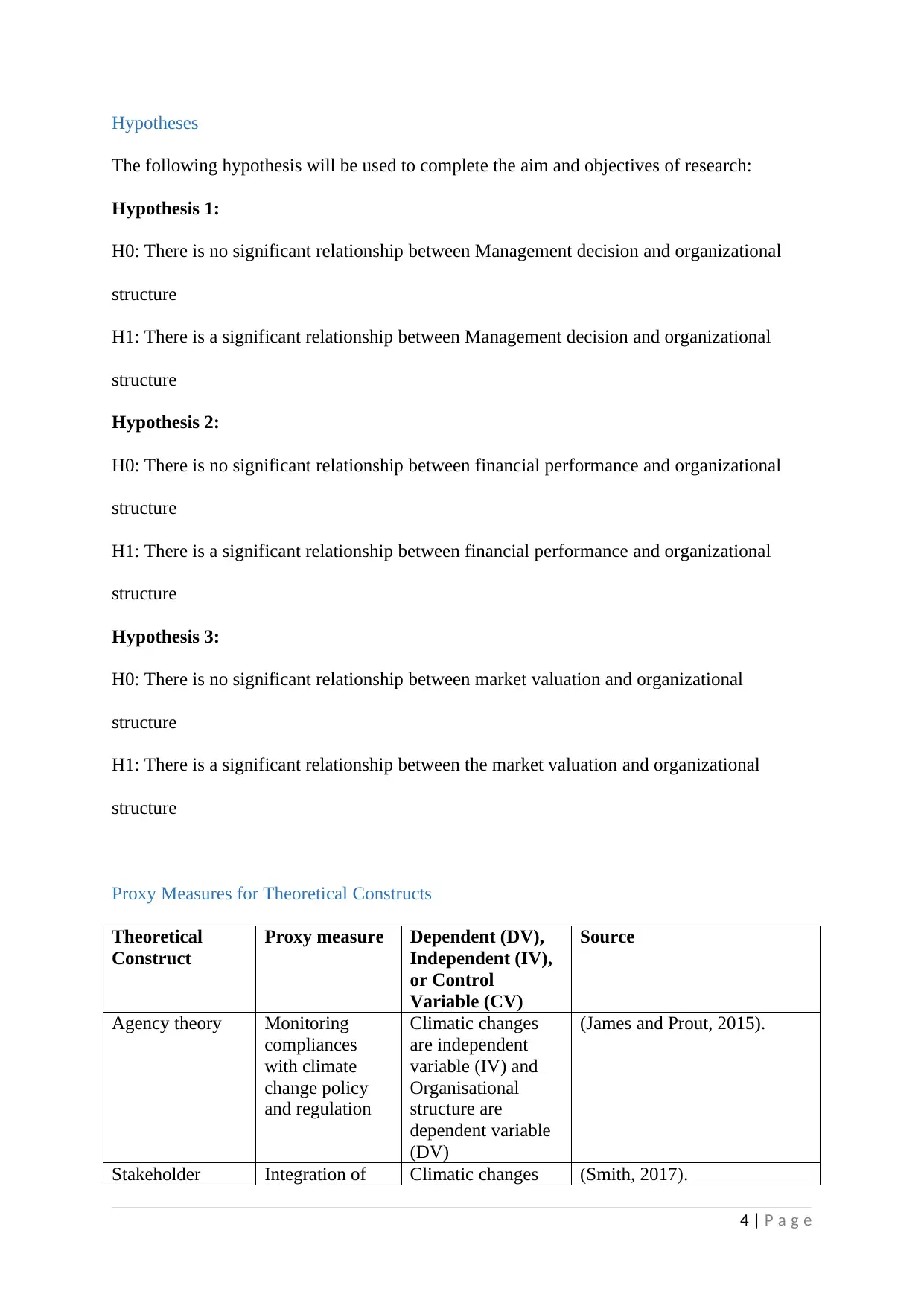
Hypotheses
The following hypothesis will be used to complete the aim and objectives of research:
Hypothesis 1:
H0: There is no significant relationship between Management decision and organizational
structure
H1: There is a significant relationship between Management decision and organizational
structure
Hypothesis 2:
H0: There is no significant relationship between financial performance and organizational
structure
H1: There is a significant relationship between financial performance and organizational
structure
Hypothesis 3:
H0: There is no significant relationship between market valuation and organizational
structure
H1: There is a significant relationship between the market valuation and organizational
structure
Proxy Measures for Theoretical Constructs
Theoretical
Construct
Proxy measure Dependent (DV),
Independent (IV),
or Control
Variable (CV)
Source
Agency theory Monitoring
compliances
with climate
change policy
and regulation
Climatic changes
are independent
variable (IV) and
Organisational
structure are
dependent variable
(DV)
(James and Prout, 2015).
Stakeholder Integration of Climatic changes (Smith, 2017).
4 | P a g e
The following hypothesis will be used to complete the aim and objectives of research:
Hypothesis 1:
H0: There is no significant relationship between Management decision and organizational
structure
H1: There is a significant relationship between Management decision and organizational
structure
Hypothesis 2:
H0: There is no significant relationship between financial performance and organizational
structure
H1: There is a significant relationship between financial performance and organizational
structure
Hypothesis 3:
H0: There is no significant relationship between market valuation and organizational
structure
H1: There is a significant relationship between the market valuation and organizational
structure
Proxy Measures for Theoretical Constructs
Theoretical
Construct
Proxy measure Dependent (DV),
Independent (IV),
or Control
Variable (CV)
Source
Agency theory Monitoring
compliances
with climate
change policy
and regulation
Climatic changes
are independent
variable (IV) and
Organisational
structure are
dependent variable
(DV)
(James and Prout, 2015).
Stakeholder Integration of Climatic changes (Smith, 2017).
4 | P a g e
Paraphrase This Document
Need a fresh take? Get an instant paraphrase of this document with our AI Paraphraser
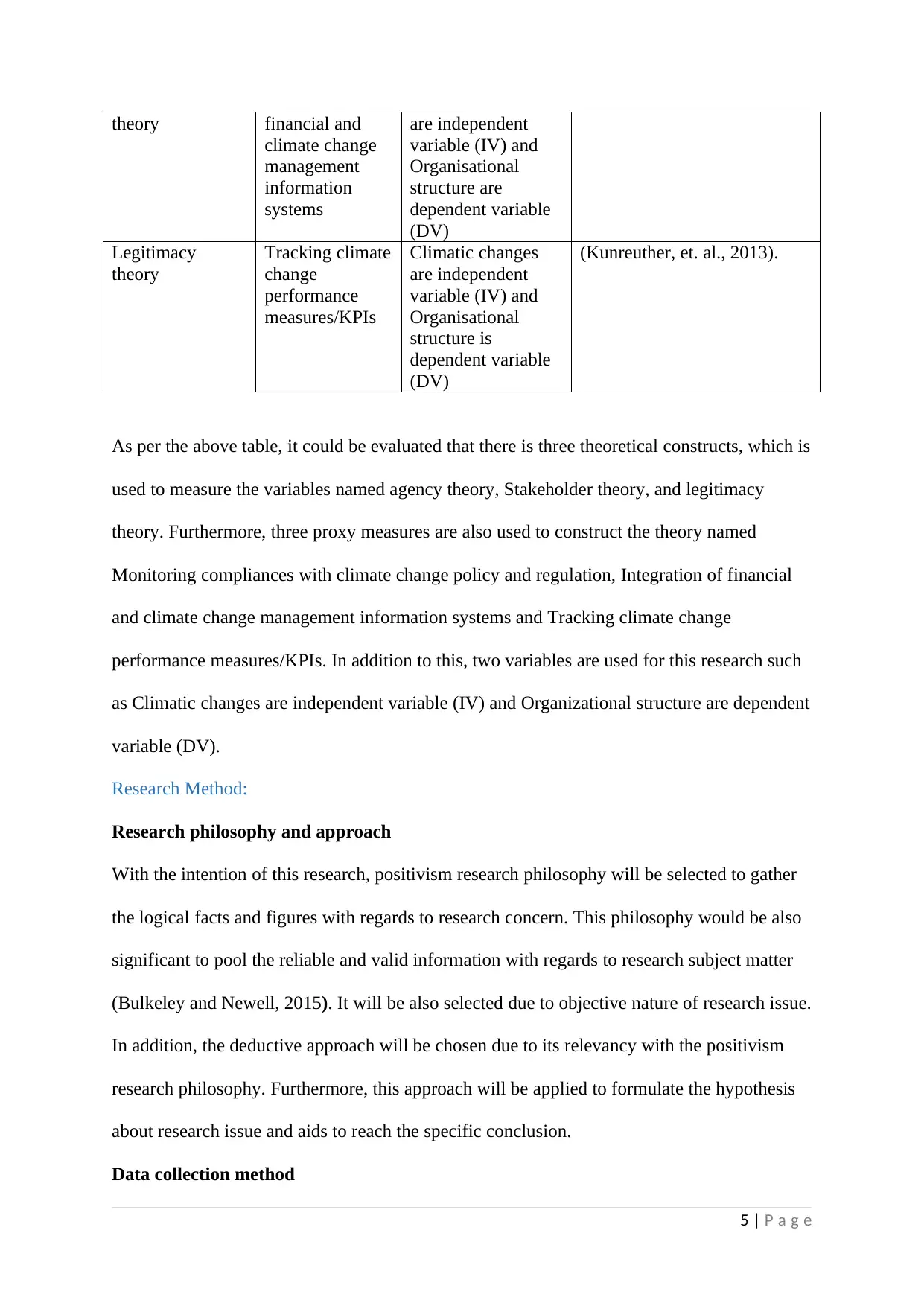
theory financial and
climate change
management
information
systems
are independent
variable (IV) and
Organisational
structure are
dependent variable
(DV)
Legitimacy
theory
Tracking climate
change
performance
measures/KPIs
Climatic changes
are independent
variable (IV) and
Organisational
structure is
dependent variable
(DV)
(Kunreuther, et. al., 2013).
As per the above table, it could be evaluated that there is three theoretical constructs, which is
used to measure the variables named agency theory, Stakeholder theory, and legitimacy
theory. Furthermore, three proxy measures are also used to construct the theory named
Monitoring compliances with climate change policy and regulation, Integration of financial
and climate change management information systems and Tracking climate change
performance measures/KPIs. In addition to this, two variables are used for this research such
as Climatic changes are independent variable (IV) and Organizational structure are dependent
variable (DV).
Research Method:
Research philosophy and approach
With the intention of this research, positivism research philosophy will be selected to gather
the logical facts and figures with regards to research concern. This philosophy would be also
significant to pool the reliable and valid information with regards to research subject matter
(Bulkeley and Newell, 2015). It will be also selected due to objective nature of research issue.
In addition, the deductive approach will be chosen due to its relevancy with the positivism
research philosophy. Furthermore, this approach will be applied to formulate the hypothesis
about research issue and aids to reach the specific conclusion.
Data collection method
5 | P a g e
climate change
management
information
systems
are independent
variable (IV) and
Organisational
structure are
dependent variable
(DV)
Legitimacy
theory
Tracking climate
change
performance
measures/KPIs
Climatic changes
are independent
variable (IV) and
Organisational
structure is
dependent variable
(DV)
(Kunreuther, et. al., 2013).
As per the above table, it could be evaluated that there is three theoretical constructs, which is
used to measure the variables named agency theory, Stakeholder theory, and legitimacy
theory. Furthermore, three proxy measures are also used to construct the theory named
Monitoring compliances with climate change policy and regulation, Integration of financial
and climate change management information systems and Tracking climate change
performance measures/KPIs. In addition to this, two variables are used for this research such
as Climatic changes are independent variable (IV) and Organizational structure are dependent
variable (DV).
Research Method:
Research philosophy and approach
With the intention of this research, positivism research philosophy will be selected to gather
the logical facts and figures with regards to research concern. This philosophy would be also
significant to pool the reliable and valid information with regards to research subject matter
(Bulkeley and Newell, 2015). It will be also selected due to objective nature of research issue.
In addition, the deductive approach will be chosen due to its relevancy with the positivism
research philosophy. Furthermore, this approach will be applied to formulate the hypothesis
about research issue and aids to reach the specific conclusion.
Data collection method
5 | P a g e

For this research, both primary and secondary data collection method will be used to gather
the facts and figures regarding the impact of climate changes on organizational structure. In
this way, primary data will be chosen as it facilitates the fresh and first-hand data about the
research objectives. As well as, secondary data will be selected to get the authentic data in
less time period. Primary data will be collected via using survey through questionnaire while
secondary will be chosen from online sources, journal articles, company report, and books.
Both data collection method will be beneficial to reach the reliable and valid conclusion.
Research design
With the intention of this research, mixed research design will be chosen to complete the
research in an effective and efficient manner. This research design will be selected as it
contains the characteristics of both qualitative and quantitative research design. Qualitative
research design will be implemented to obtain the theoretical information associated with
objectives of research while quantitative research design will be executed to gather the
numerical facts and figures regarding research issue. Furthermore, causal research will be
used to assess the relationship between two variable i.e. climate change and organizational
structure.
Sampling process
Probability sampling procedure will be selected to choose the sample from the high amount
of population on the random basis. Under this process, random sampling method will be
selected to provide equal opportunity to participants as it will aid to remove biases from
research. Further, 40 employees will be selected as a sample size from a set of
telecommunication company of UK to conduct the survey through a questionnaire.
Time plan
6 | P a g e
the facts and figures regarding the impact of climate changes on organizational structure. In
this way, primary data will be chosen as it facilitates the fresh and first-hand data about the
research objectives. As well as, secondary data will be selected to get the authentic data in
less time period. Primary data will be collected via using survey through questionnaire while
secondary will be chosen from online sources, journal articles, company report, and books.
Both data collection method will be beneficial to reach the reliable and valid conclusion.
Research design
With the intention of this research, mixed research design will be chosen to complete the
research in an effective and efficient manner. This research design will be selected as it
contains the characteristics of both qualitative and quantitative research design. Qualitative
research design will be implemented to obtain the theoretical information associated with
objectives of research while quantitative research design will be executed to gather the
numerical facts and figures regarding research issue. Furthermore, causal research will be
used to assess the relationship between two variable i.e. climate change and organizational
structure.
Sampling process
Probability sampling procedure will be selected to choose the sample from the high amount
of population on the random basis. Under this process, random sampling method will be
selected to provide equal opportunity to participants as it will aid to remove biases from
research. Further, 40 employees will be selected as a sample size from a set of
telecommunication company of UK to conduct the survey through a questionnaire.
Time plan
6 | P a g e
⊘ This is a preview!⊘
Do you want full access?
Subscribe today to unlock all pages.

Trusted by 1+ million students worldwide
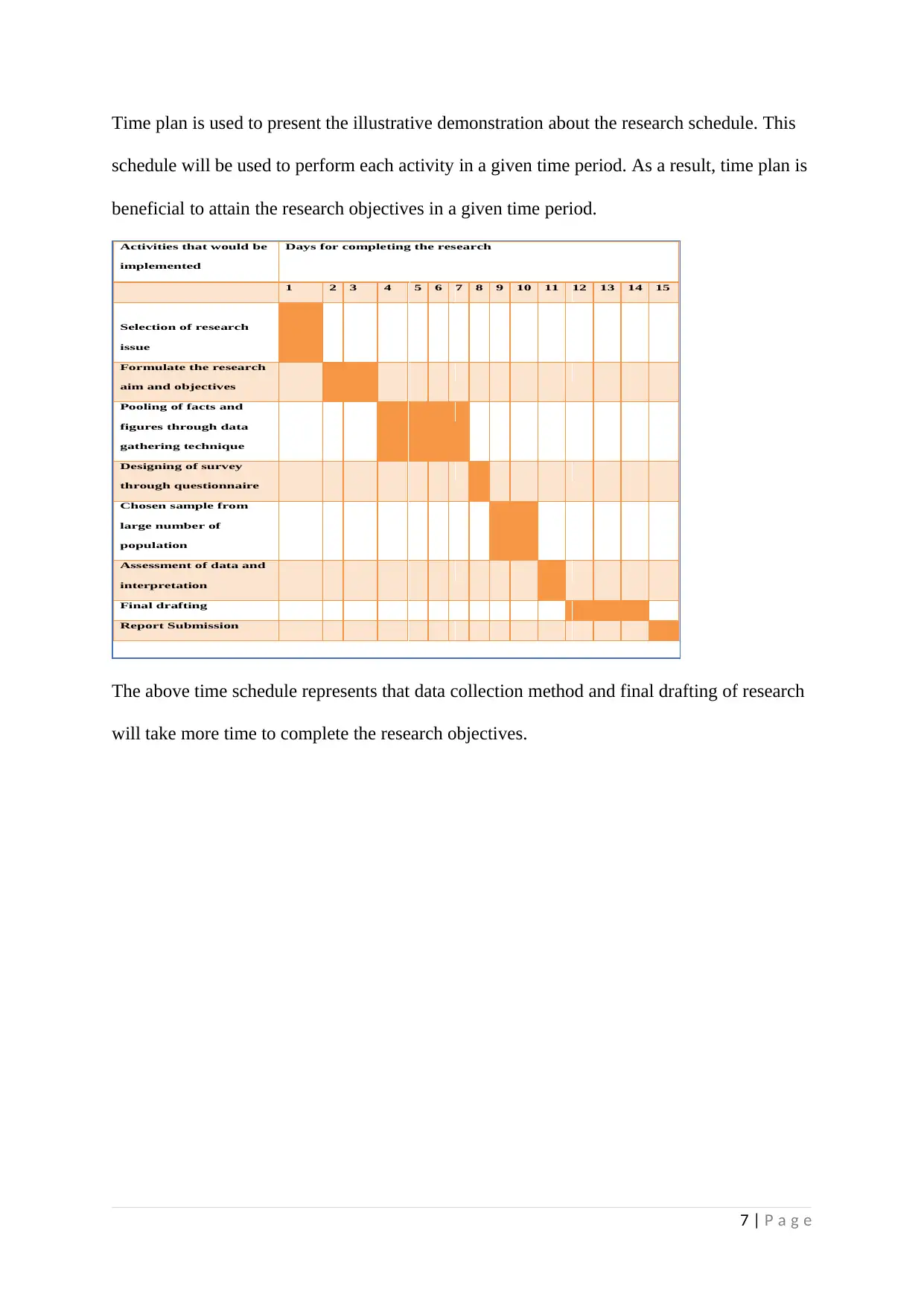
Time plan is used to present the illustrative demonstration about the research schedule. This
schedule will be used to perform each activity in a given time period. As a result, time plan is
beneficial to attain the research objectives in a given time period.
Activities that would be
implemented
Days for completing the research
1 2 3 4 5 6 7 8 9 10 11 12 13 14 15
Selection of research
issue
Formulate the research
aim and objectives
Pooling of facts and
figures through data
gathering technique
Designing of survey
through questionnaire
Chosen sample from
large number of
population
Assessment of data and
interpretation
Final drafting
Report Submission
The above time schedule represents that data collection method and final drafting of research
will take more time to complete the research objectives.
7 | P a g e
schedule will be used to perform each activity in a given time period. As a result, time plan is
beneficial to attain the research objectives in a given time period.
Activities that would be
implemented
Days for completing the research
1 2 3 4 5 6 7 8 9 10 11 12 13 14 15
Selection of research
issue
Formulate the research
aim and objectives
Pooling of facts and
figures through data
gathering technique
Designing of survey
through questionnaire
Chosen sample from
large number of
population
Assessment of data and
interpretation
Final drafting
Report Submission
The above time schedule represents that data collection method and final drafting of research
will take more time to complete the research objectives.
7 | P a g e
Paraphrase This Document
Need a fresh take? Get an instant paraphrase of this document with our AI Paraphraser
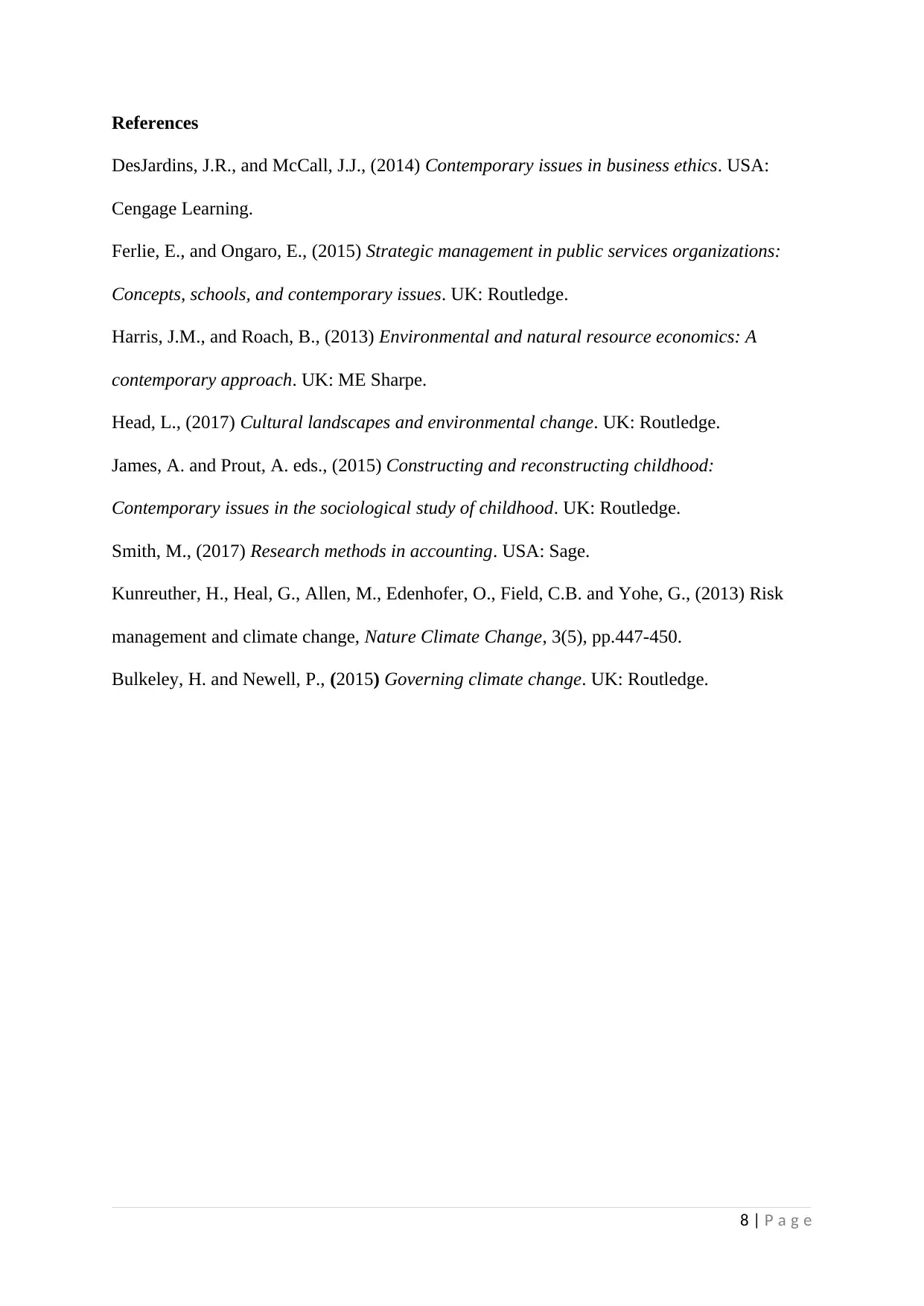
References
DesJardins, J.R., and McCall, J.J., (2014) Contemporary issues in business ethics. USA:
Cengage Learning.
Ferlie, E., and Ongaro, E., (2015) Strategic management in public services organizations:
Concepts, schools, and contemporary issues. UK: Routledge.
Harris, J.M., and Roach, B., (2013) Environmental and natural resource economics: A
contemporary approach. UK: ME Sharpe.
Head, L., (2017) Cultural landscapes and environmental change. UK: Routledge.
James, A. and Prout, A. eds., (2015) Constructing and reconstructing childhood:
Contemporary issues in the sociological study of childhood. UK: Routledge.
Smith, M., (2017) Research methods in accounting. USA: Sage.
Kunreuther, H., Heal, G., Allen, M., Edenhofer, O., Field, C.B. and Yohe, G., (2013) Risk
management and climate change, Nature Climate Change, 3(5), pp.447-450.
Bulkeley, H. and Newell, P., (2015) Governing climate change. UK: Routledge.
8 | P a g e
DesJardins, J.R., and McCall, J.J., (2014) Contemporary issues in business ethics. USA:
Cengage Learning.
Ferlie, E., and Ongaro, E., (2015) Strategic management in public services organizations:
Concepts, schools, and contemporary issues. UK: Routledge.
Harris, J.M., and Roach, B., (2013) Environmental and natural resource economics: A
contemporary approach. UK: ME Sharpe.
Head, L., (2017) Cultural landscapes and environmental change. UK: Routledge.
James, A. and Prout, A. eds., (2015) Constructing and reconstructing childhood:
Contemporary issues in the sociological study of childhood. UK: Routledge.
Smith, M., (2017) Research methods in accounting. USA: Sage.
Kunreuther, H., Heal, G., Allen, M., Edenhofer, O., Field, C.B. and Yohe, G., (2013) Risk
management and climate change, Nature Climate Change, 3(5), pp.447-450.
Bulkeley, H. and Newell, P., (2015) Governing climate change. UK: Routledge.
8 | P a g e
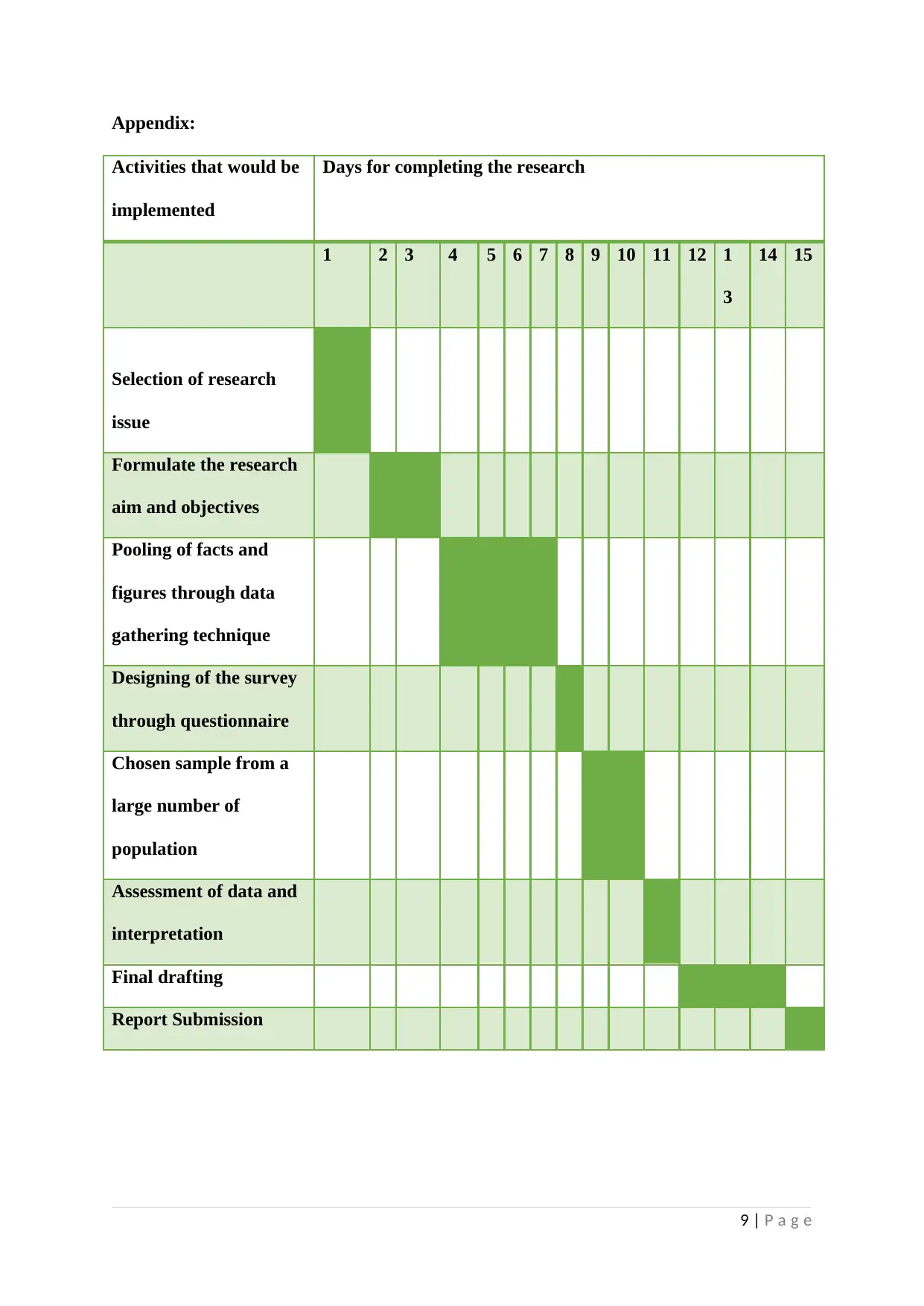
Appendix:
Activities that would be
implemented
Days for completing the research
1 2 3 4 5 6 7 8 9 10 11 12 1
3
14 15
Selection of research
issue
Formulate the research
aim and objectives
Pooling of facts and
figures through data
gathering technique
Designing of the survey
through questionnaire
Chosen sample from a
large number of
population
Assessment of data and
interpretation
Final drafting
Report Submission
9 | P a g e
Activities that would be
implemented
Days for completing the research
1 2 3 4 5 6 7 8 9 10 11 12 1
3
14 15
Selection of research
issue
Formulate the research
aim and objectives
Pooling of facts and
figures through data
gathering technique
Designing of the survey
through questionnaire
Chosen sample from a
large number of
population
Assessment of data and
interpretation
Final drafting
Report Submission
9 | P a g e
⊘ This is a preview!⊘
Do you want full access?
Subscribe today to unlock all pages.

Trusted by 1+ million students worldwide
1 out of 9
Related Documents
Your All-in-One AI-Powered Toolkit for Academic Success.
+13062052269
info@desklib.com
Available 24*7 on WhatsApp / Email
![[object Object]](/_next/static/media/star-bottom.7253800d.svg)
Unlock your academic potential
Copyright © 2020–2025 A2Z Services. All Rights Reserved. Developed and managed by ZUCOL.





